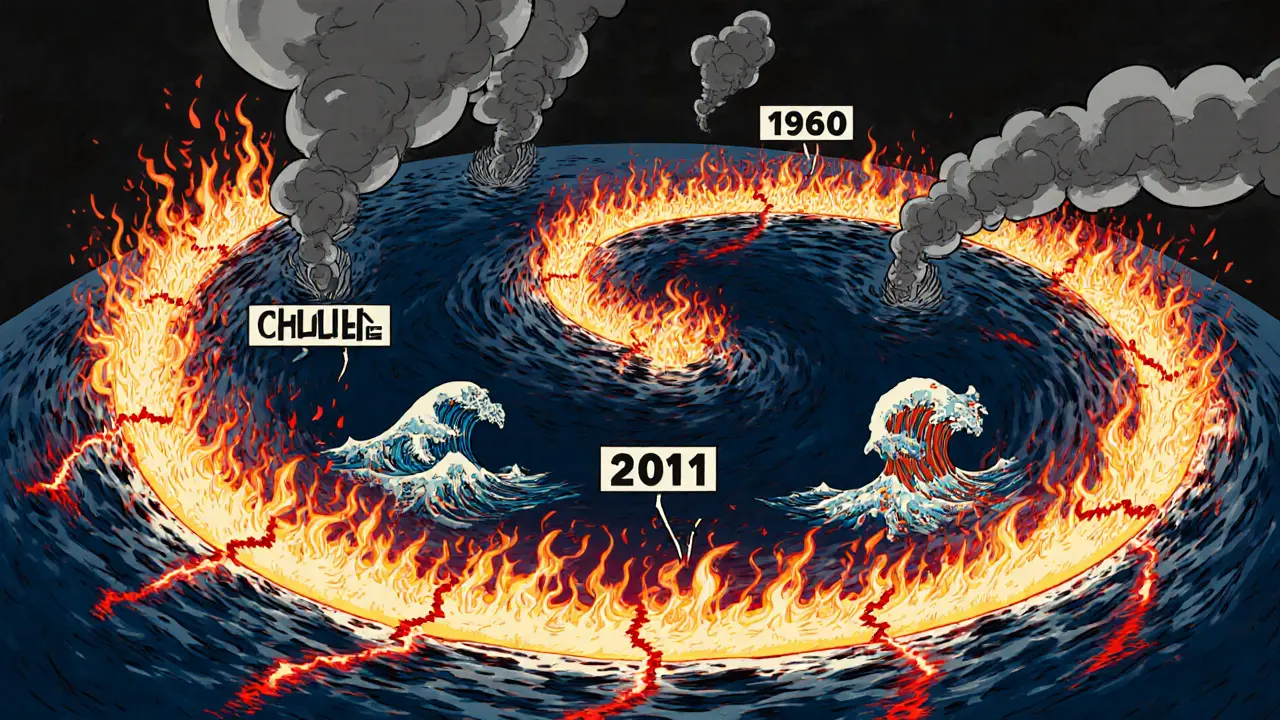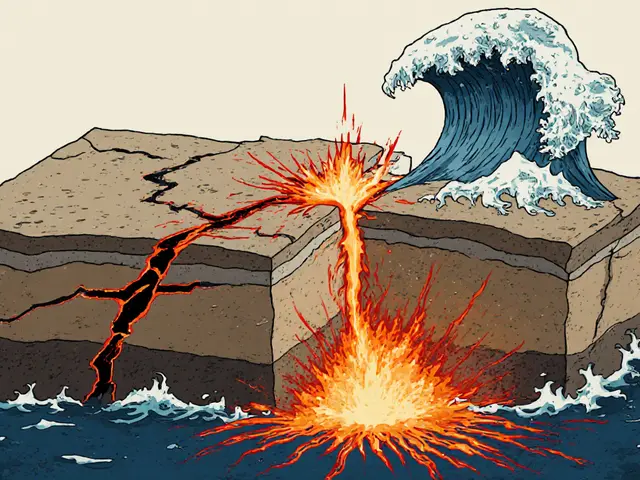When the ground shakes so hard it flips cars, cracks open the earth, and sends walls of water racing across oceans, you’re not just feeling an earthquake-you’re feeling a tectonic earthquake. Known as tektonski potres in Slovenian and siêu động đất in Vietnamese, these are not ordinary tremors. They are the planet’s most violent releases of energy, born from the slow, grinding collision of tectonic plates. And when they happen, they change everything.
What Makes a Tectonic Earthquake Different?
Not all earthquakes are the same. Some are caused by volcanoes, others by mining or reservoirs filling with water. But the biggest, the deadliest, the ones that shake continents-those come from tectonic plates. These are the massive slabs of Earth’s crust that float on the hot, slow-moving mantle below. When they get stuck, pressure builds. And when they finally slip, it’s not a crack. It’s a rupture that can stretch hundreds of kilometers. The most powerful of these happen at subduction zones, where one plate dives under another. Think of it like a giant sheet of paper being shoved under a stack of books. The friction locks it in place for decades, even centuries. Then-suddenly-it gives way. The energy released in those seconds can be thousands of times stronger than the atomic bomb dropped on Hiroshima. These are called megathrust earthquakes. They don’t just shake the ground-they lift entire sections of the seafloor, displacing trillions of tons of water. That’s what creates the monstrous tsunamis we see in the news. The 2004 Indian Ocean quake didn’t just kill 230,000 people. It shifted the Earth’s axis by a few centimeters. The 2011 Tōhoku earthquake in Japan moved the main island of Honshu 2.4 meters eastward.The Ring of Fire: Earth’s Most Dangerous Belt
If you look at a map of the world’s earthquakes, one pattern jumps out: a giant horseshoe wrapping around the Pacific Ocean. That’s the Ring of Fire. It’s not a ring of fire-it’s a ring of crushing plates. Here, the Pacific Plate is diving under the North American, Eurasian, and Indo-Australian Plates. This is where 81% of the world’s largest earthquakes happen. The 1960 Valdivia earthquake in Chile? Mw 9.5. Still the strongest ever recorded. It triggered tsunamis that hit Hawaii, Japan, and the Philippines. The 1964 Alaska quake? Mw 9.2. It flipped the landscape, lifting entire forests out of the water. The 2011 Tōhoku quake? Mw 9.0-9.1. It caused the Fukushima nuclear disaster and remains the costliest natural disaster in history, with losses exceeding $360 billion. These aren’t rare. They happen every few decades. And they always happen in the same places-because the plates keep moving.How Deep Do They Go?
Most people think earthquakes happen deep underground. But the biggest ones? They start shallow. Between 0 and 30 kilometers down. That’s surprisingly close to the surface. The 2004 Sumatra quake struck at 30 km. The 2011 Japan quake was at 29 km. In Slovenia, most quakes happen between 6 and 9 km deep. Why does depth matter? Because shallow quakes shake the ground harder. They don’t lose energy traveling up. And when they happen under the ocean, they displace water instantly-no warning, no time to react. Deeper quakes, like those at 100-300 km, can be powerful too, but they don’t cause tsunamis. They’re like muffled thunder. The shallow ones? They’re a sledgehammer to the surface.
How We Measure the Unmeasurable
Earthquake magnitude isn’t measured on a simple scale. It’s logarithmic. That means each whole number increase equals 31.6 times more energy. A magnitude 8 quake releases 31.6 times more energy than a 7. A 9? That’s 1,000 times more than an 8. The Richter scale is outdated. Today, scientists use the moment magnitude scale (Mw). It’s more accurate for huge quakes. The 2004 Indian Ocean quake was Mw 9.1-9.3. The 1960 Chile quake? Mw 9.5. No other natural event on Earth releases this kind of energy-except maybe asteroid impacts. Intensity, on the other hand, is what you feel. The European Macroseismic Scale (EMS) rates damage from I (not felt) to XII (total destruction). In 2005, Slovenia recorded 12 events at EMS IV-strong enough to rattle windows, wake people up, but not destroy buildings. The 2011 Japan quake? In some coastal towns, it reached EMS XII. Entire neighborhoods vanished.Can We Predict Them?
No. Not really. Despite decades of research, no scientist can say, “This fault will rupture on March 12, 2026, at 3:47 a.m.” We can’t predict earthquakes. But we can estimate where they’re likely to happen-and how often. In California, the UCERF3 model gives a 95% confidence interval for major quakes over 30 years. It says there’s a 72% chance of a Mw 6.7 or larger quake in Southern California before 2050. In Japan, scientists monitor the Nankai Trough with ocean-bottom sensors, watching for tiny movements that might signal stress building up. They can’t say when it will break-but they know it will. The 2011 Tōhoku quake was a shock because it was bigger than anyone predicted. Models said a Mw 8.5 was possible. It was Mw 9.1. That’s why scientists now assume the worst-case scenario when planning for subduction zones.How Japan and Slovenia Are Getting Better at Surviving
Japan didn’t just survive the 2011 quake. It adapted. Its Earthquake Early Warning system, launched in 2007, detected the quake 5.8 seconds before shaking hit Tokyo. That’s not much-but it’s enough to stop trains, shut off gas lines, and tell people to drop and cover. In schools, drills are mandatory. Buildings are built to sway, not break. Even smartphones get alerts. Slovenia, a smaller country with fewer resources, uses something more grassroots: citizen scientists. Over 4,900 volunteers report what they felt after every quake. That data helps map intensity across towns and valleys. In the 2005 Posočje earthquake, those reports revealed hidden landslides and soil liquefaction-where wet ground turned to quicksand during shaking. New tools are helping too. LiDAR scans, mounted on planes, can see through forests and find ancient fault lines buried under trees. In western Slovenia, researchers used this to discover previously unknown ruptures from earthquakes 500 years ago. That means they can now model future risks with far more accuracy.
What Comes Next?
The next super earthquake won’t be a surprise. It’ll be expected. Somewhere along the Ring of Fire-off the coast of Chile, in the Aleutians, near Sumatra, or in the Nankai Trough-it’s already building. We know the faults. We know the history. We know the patterns. What we don’t have yet is perfect early warning for every coastal community. We don’t have every building retrofitted. We don’t have every family prepared. The science is advancing. Sensors are cheaper. AI models are learning from 110 years of quake data. But technology only helps if people use it. The next megathrust quake will be devastating. But it doesn’t have to be a catastrophe. Preparedness saves lives. Knowing your evacuation route. Having an emergency kit. Understanding that a strong shake near the coast means run uphill-immediately. The Earth doesn’t warn us. But we’re learning how to listen.Why Other Quakes Don’t Compare
Volcanic quakes? They’re small. Usually under Mw 5.0. Caused by magma moving underground. They’re loud, but localized. Quakes from fracking or reservoirs? Even smaller. Mw 4-5. Rarely cause damage beyond cracked walls. They’re human-made, and they’re contained. Tectonic earthquakes? They’re natural, massive, and unstoppable. They’re the only type that can crack continents, trigger global tsunamis, and rewrite coastlines in seconds. There’s no other force on Earth that can do that.What You Need to Know If You Live Near a Fault
If you live near the Pacific, the Mediterranean, or any active plate boundary:- Know your zone. Is it a subduction zone? A transform fault? The risk level changes.
- Have a plan. Where will you meet your family? Where’s your emergency kit?
- Practice drop, cover, hold on. Do it every month.
- If you’re near the coast and feel a long, strong shake-run to high ground. Don’t wait for a warning.
- Keep a battery-powered radio. Cell networks fail. Power goes out.


Cody Leach
The way tectonic plates lock and then snap is like a rubber band stretched too far. It’s not magic, it’s physics. And the energy release? Pure, raw geology. We’re talking about forces that make human engineering look like toys.
sandeep honey
Why do we keep building cities right on top of these fault lines? We know they’re ticking time bombs. We have the data. We know the history. So why do we act like we’re surprised every time? It’s not fate-it’s negligence.
Mandy Hunt
They say we can’t predict earthquakes but what if they’re not natural at all? What if the government is hiding the real cause? I’ve read about HAARP and underground experiments. The timing of these quakes is too convenient. Fukushima? Not an accident. It was a cover-up.
anthony silva
So the earth shakes. Big deal. I’ve seen my cat knock over a vase with more force than most quakes. At least the planet’s got drama. Meanwhile I’m stuck in traffic trying to get my latte.
David Cameron
We measure quakes in magnitude but we don’t measure how much we’ve forgotten how to fear nature. We build skyscrapers like we own the ground. We think tech will save us. But the earth doesn’t care about our apps or our alerts. It’s older than our languages. We’re just guests here.
Sara Lindsey
Stop waiting for the next big one to hit. Start preparing today. Grab a backpack. Put in water. Flashlight. Batteries. A whistle. Do it now. Don’t wait until your floor is rolling like a wave. You’ll wish you had. I’m not saying it’s easy. I’m saying it’s urgent.
alex piner
Man I live near the san andreas and honestly I never thought about it till i read this. Now i got a kit in my closet and i did a drill with my roommate. We laughed but it felt good. We’re not ready but we’re trying. That counts right?
Mauricio Picirillo
For anyone scared about this-don’t panic. Just know your zone. Know your exit. Know your neighbors. Community saves lives more than tech ever will. And if you’re in a coastal area? When the ground stops shaking, start running uphill. No waiting. No texting. Just move.
Liz Watson
Oh wow a blog post with bullet points and a cute little map. How original. Did you get this from National Geographic’s ‘Earth for Dummies’? The real science is way more complex and you just turned it into a TED Talk script.
Rachel Anderson
They say the earth moves. But what if it’s not the earth? What if it’s the weight of our collective guilt? The way we’ve destroyed forests, poisoned oceans, burned the sky. Maybe the planet isn’t shaking-it’s screaming. And we’re too busy scrolling to hear it.
Hamish Britton
Had a mate in Wellington tell me about the ‘90s quake. Said the whole city just… paused. No cars. No sirens. Just silence. Then people started walking out, checking on each other. No phones. No apps. Just human stuff. We forget that. We think tech protects us. But it’s people who hold things together.
Robert Astel
So like i was reading this and it made me think about how everything is connected right like the plates are moving and the oceans are rising and we’re all just kinda floating on this giant rock that’s slowly turning into a giant hot potato and honestly i think we’re all just one big cosmic joke and the earth is just waiting for us to stop being so loud so it can finally nap like a cat on a windowsill
Drew Monrad
They talk about preparedness like it’s a moral duty. Like if you don’t have a GoBag you’re a bad person. But what about the people who can’t afford to retrofit their homes? What about the single mom working two jobs? You think she’s got time to learn LiDAR data? You think she’s got $20,000 to rebuild? This isn’t about willpower. It’s about inequality dressed up as science.